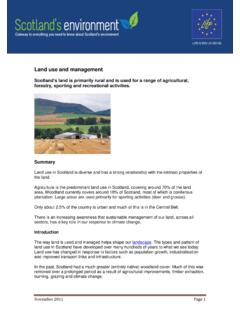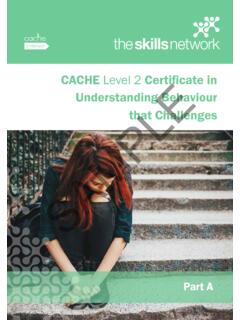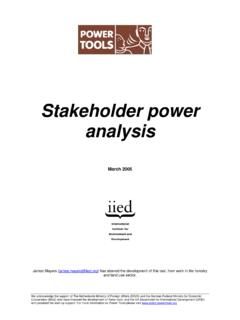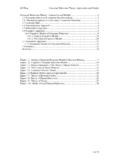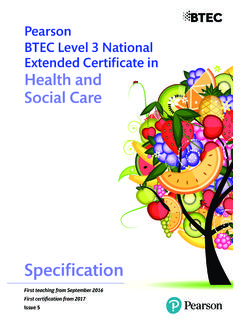Transcription of UNDERSTANDING BEHAVIOUR CHANGE How to apply …
1 SEWeb LIFE+ Project Action Number 04 UNDERSTANDING BEHAVIOUR CHANGE How to apply theories of BEHAVIOUR CHANGE to SEWeb and related public engagement activities Katrin Prager, James Hutton Institute May 2012 UNDERSTANDING BEHAVIOUR CHANGE How to apply theories of BEHAVIOUR CHANGE to SEWeb and related public engagement activities Katrin Prager, James Hutton Institute Report for SEWeb LIFE10 ENV-UK-000182 May 2012 Katrin Prager Theories of BEHAVIOUR CHANGE April 2012 3 Contents 1. Introduction .. 5 2. Social-psychological theories of BEHAVIOUR and CHANGE .. 7 Rational Choice .. 7 Theory of Reasoned Action & Theory of Planned BEHAVIOUR .
2 8 Value-Belief-Norm Theory & Theory of Interpersonal BEHAVIOUR .. 8 Persuasion theory .. 10 Beginnings .. 10 Elaboration Likelihood Model .. 10 Social learning theory, and what motivates people to 11 Community-based Social Marketing & Adoption Theory .. 12 3. Summary .. 16 4. Recommendations .. 17 How can policy influence behaviours .. 17 How can SEWeb influence behaviours .. 18 5. References .. 20 22 Katrin Prager Theories of BEHAVIOUR CHANGE April 2012 4 Foreword This report is written to help partners involved in the development of Scotland s Environment Website (SEWeb) to better understand what motivates BEHAVIOUR and how behaviours can be influenced.
3 A draft of this report was presented to and discussed with a small group of SEWeb partners on 22 March 2012, and subsequently revised. The final report is to be presented at the workshop on What can theory tell us about BEHAVIOUR CHANGE through policy and SEWeb (planned for June 2012). An Annex will capture the feedback received and any output generated at the workshop in order to complement the report. The theories discussed here are also applicable to the broader suite of environmental policies since environmental protection and improved environmental management, through communication, policy and planning, often ultimately requires changes in BEHAVIOUR for effective implementation.
4 The aim is to achieve policy impact and to make a lasting difference on the ground, based on an UNDERSTANDING of the principles of BEHAVIOUR CHANGE . The aim of the research programme underlying the public engagement work stream of the SEWeb project is to test the hypothesis that better on-line information about the environment (both in terms of what information people need and how they need it presented) supports the move to increased engagement in debating environmental priorities, monitoring the environment and taking action to protect it (or, put differently, the ultimate purpose of the provision of environmental information is to stimulate BEHAVIOUR CHANGE to better appreciate, use, manage and protect the environment).
5 Katrin Prager Theories of BEHAVIOUR CHANGE April 2012 5 1. Introduction Policy development in the context of behavioural CHANGE is notoriously difficult. (Jackson, 2005, 3) The sheer complexity of human behaviours and motivations makes it very hard to predict with certainty what the impacts of policy interventions on people s BEHAVIOUR are going to be. (Jackson, 2005, 119) The importance of influencing BEHAVIOUR in order to achieve positive policy outcomes is increasingly recognised and has led to a number of reviews and reports. Some of these cover the use of BEHAVIOUR CHANGE models in general (Darnton, 2008b) while others focus on behaviours relevant to specific contexts such as climate CHANGE (Southerton et al.)
6 , 2011), sustainable consumption (Jackson, 2005), or the impact of volunteering on environmental BEHAVIOUR (Hine et al., 2008). Behavioural theories and models of behavioural CHANGE cannot bring about BEHAVIOUR CHANGE , nor can they predict with certainty what changes in BEHAVIOUR will occur. Nevertheless, they can inform policy makers, implementers and others involved in trying to bring about CHANGE about the issues to consider and the likely success of initiatives and interventions. This report aims to aid the UNDERSTANDING why and how BEHAVIOUR CHANGE occurs and what the factors and conditions are that drive behaviours .
7 As Michie et al. (2008) note, theory provides a helpful basis for designing interventions to CHANGE BEHAVIOUR but offers little guidance on how to do this . The authors go on to develop an extensive list of BEHAVIOUR CHANGE techniques (with definitions) and link the techniques to theoretical constructs. However, even though they outline the possibility of developing a comprehensive, reliable taxonomy of techniques linked to theory, there still is no guidance on how a policy maker or anyone else wishing to influence, for example, environmental BEHAVIOUR would pick the relevant techniques. This report tries to provide readers with a better UNDERSTANDING of the mechanisms and processes that underlie human BEHAVIOUR in order to then decide on which approaches are suitable to achieve BEHAVIOUR Before embarking on a discussion around what theories of behavioural CHANGE can tell us about the best way to influence BEHAVIOUR , those wishing to CHANGE BEHAVIOUR need to answer the following questions: 1.
8 Whose BEHAVIOUR should be changed? 2. What BEHAVIOUR should be changed? 3. What CHANGE do we wish to see and how can we tell that it has happened? 1 Recent notions in a number of government bodies and agencies have been to avoid the term BEHAVIOUR CHANGE because it is associated with a top-down, psychological imperative, something imposed by government (Paul Tyrer, by email, 19 March 2012). Therefore, I preferred the term influence over CHANGE but this could not be done consistently because the body of theories is explicitly built around the term BEHAVIOUR CHANGE .
9 Katrin Prager Theories of BEHAVIOUR CHANGE April 2012 6 4. Why should these behaviours CHANGE ? There are a few highlights from a broad range of theories2 that need to be kept in mind whenever designing tools or policy interventions to influence BEHAVIOUR . As Kathryn Mearns (2012) pointed out, BEHAVIOUR is very resistant to CHANGE : People are creatures of habit, and we try to achieve maximum gain with minimum effort; Information and exhortation are among the least effective ways of influencing BEHAVIOUR (Bandura, 1977; Campbell, 1963), even if people are informed about health risks ( smoking, obesity); We are focused on the short-term not the long-term (immediate survival was critical for our ancestors; in contrast, the very gradual, slow pace of environmental CHANGE represents a cognitive barrier (Kollmuss and Agyeman, 2002)).
10 We do not necessarily respond well to being told what to do (related to ideas of personal freedom/rights especially in Western societies (Branson et al., 2012)). It is important to distinguish between two types of theories. Some theories and models are well suited for a heuristic (comprehensive, conceptual) UNDERSTANDING of behaviours . They are able to capture the wide variety of different factors3 that influence choices and behaviours and fulfil a conceptual role. However, these complex models are not necessarily good for empirical testing. They are too complex to allow for obtaining quantitative evidence about real attitudes and behaviours .

